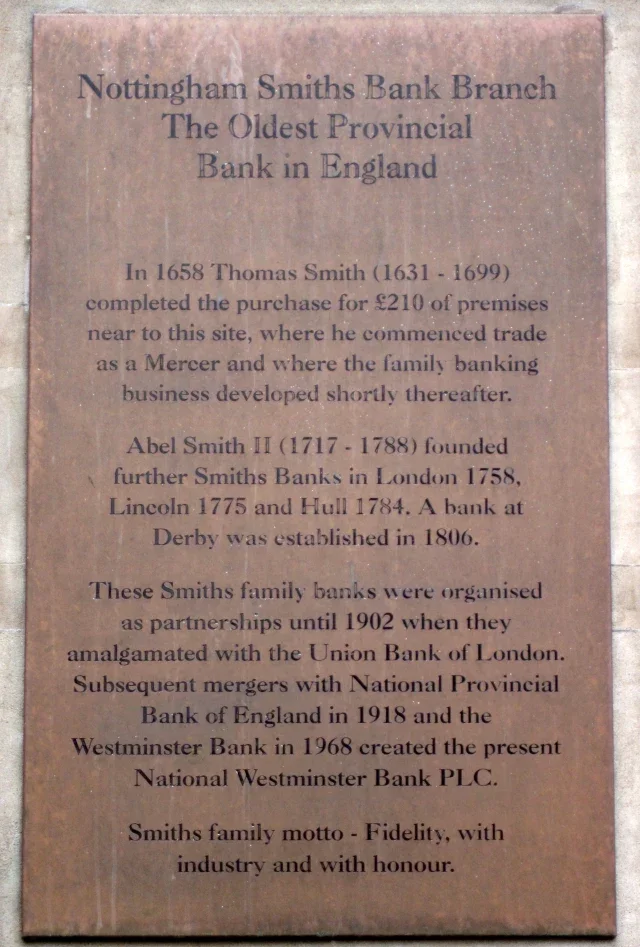Learning Resource
Nottingham City Review of Statues and Plaques
By
Dr James Dawkins, University of Nottingham, October, 2020
Nottingham City Council commissioned a review of the city’s statues, plaques and street-names in response to the national debate currently taking place on racial injustice and the appropriateness of commemorative iconography linked to British transatlantic slavery and empire.
Take a look through some of the selected Statues and Plaques.
A full reference or loan copy is available in the Local Studies library, Nottingham Central Library.
or read the report in full by clicking here
-
Memorial: Plaque
Location: NatWest Bank, South Parade, Nottingham City Centre
Slavery Link: Yes
Link Type: Indirect
Nature of Link: Family members were slave-ownersAbel Smith II was a banker for the Smiths Bank, a family owned business that was established by his grandfather, Thomas Smith (1631-1699), in the mid-seventeenth century. He took over its management upon his father's death in 1757 and in 1758 entered into a partnership with John Payne (1708-1764), a London linen draper, and formed Smith, Payne & Smiths bank which had offices in both London and Nottingham. Abel went on to found two other branches of the Smiths’ bank at Lincoln in 1775 and Hull in 1784, for which he is locally celebrated and memorialised by the large plaque mounted on the side of the NatWest Bank’s exterior wall in Nottingham City Centre.
Abel II and the Smiths Bank fortunes were partly derived from the extension of credit to local textile industrialists (e.g. Strutts, Morleys) whose businesses spun and manufactured cotton picked by people of African descent enslaved in the Caribbean and Americas during the late- eighteenth and early-nineteenth centuries. The bank also earnt interest on the credit it extended to slave- owning families such as the Dukes of Portland. Moreover, its London Branch, trading under the name Smith, Payne and Smiths, is recorded as transferring enslaved people to other slave-owners in 1823.
Abel II’s son, Robert Smith (1752-1838), 1st Baron Carrington, appears to have become a slave-owner in 1798 after purchasing a 66 per cent share in three estates located in Jamaica. These were Farm, Cow Park, and Halfway Tree, which were 750, 470 and 230 acres respectively. Attached to the properties were a total of 237 enslaved people of African descent. Robert Smith paid £19,117 to bankers Samuel Smith, René Payne, and George Smith and John Smith (Smith, Payne and Smiths bank) for his share, effectively becoming the largest proprietor of these three estates, with Samuel and René owning smaller portions. It is not entirely clear how the Jamaican properties came into the possession of Smith, Payne and Smiths, although this may have occurred through a foreclosure on, and subsequent acquisition of, the properties after their previous owner was unable to service the debt owed to the bank. This was not uncommon and occurred in numerous cases throughout the period of transatlantic slavery.
Robert Smith eventually became the sole proprietor of the Farm estate and was awarded £4,900 as compensation for the emancipation of 268 people of African descent enslaved upon the property in 1834.
-
Memorial: Plaque
Location: National Justice Museum, High Pavement, Nottingham, Nottinghamshire, NG1 1HN
Slavery Link: Yes
Link Type: Indirect
Nature of Link: Descendant of enslaved AfricansEric Irons was born in Spanish Town,
Jamaica, in 1921 and was of Black African heritage. The island-wide census taken in 2011 identified 92.1% of Jamaica’s population as of African origin, the vast majority of whom descend from those forcibly transported to and enslaved upon the island by the Spanish and British between 1494 and 1833/34.Recruited into the Royal Air Force in Jamaica during World War 2, Irons was stationed in Little Rissington. He extended his service in the UK for a further 5 years, settled in Nottingham and later campaigned for racial equality and social justice due to the prejudice and mistreatment received by migrants from Britain’s colonies.
In 1962, Irons became Britain’s first Black Justice of the Peace (magistrate). He was awarded an OBE (Order of the British Empire) in 1978 as a champion for social justice and continued to serve as a magistrate in Nottingham until retiring in 1991.
-
Memorial: Statue
Location: Nottingham Arboretum, Waverley St, Nottingham, NG7 4HF
Slavery Link: Yes
Link Type: Direct
Nature of Link: Anti-slavery activistFeargus O’Connor was born in Ireland around 1796. He was educated at Trinity College, Dublin, subsequently entered the legal profession and became a lawyer. O’Connor also focussed his attention on democratic political reform and emerged as an advocate of Irish rights in the early 1830s.
O’Connor was a prominent individual who belonged to the Chartist lobby, which also opposed slavery. He was the founder and proprietor of the Northern Star newspaper, which ran weekly from 1837 to 1852, and was prominent for its publication of pieces advancing social reform in the United Kingdom and its colonies. O’Connor employed a number of correspondents who commented upon the agency of enslaved Africans and the descendants of the enslaved by publicising the details of activities they undertook in efforts to control their own lives and shape their own history. In 1851, for example, the Star highlighted the election of a “Brown man” to the Jamaican assembly, drawing attention to his occupation of a post in which he could exert power and influence in Britain’s colonies.
O'Connor was elected as a Member of Parliament (MP) for Nottingham in 1847, making him the city’s first and only Chartist MP.
Standing In This Place Podcast
Listen to Dr James Dawkins on our podcast series


